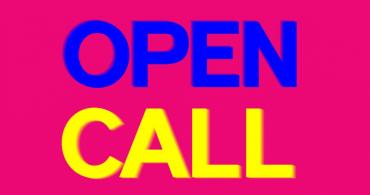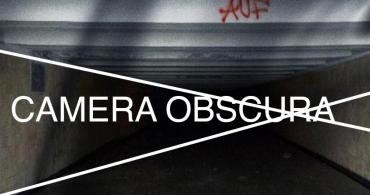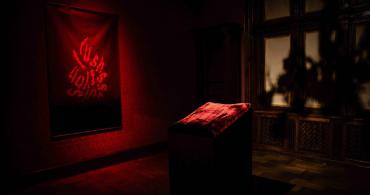Zhanna Kadyrova. Daily Bread — A First Retrospective in Hannover

Panoramic photographs overlooking the Left Bank of Kyiv. The nitrogen solution stains on the photographs are explosions over residential high-rises in Zhanna Kadyrova's Experiments series, which was first shown in Kyiv in 2014. When the war began, the front line was too far from Rusanivski Sady (the area on the Left Bank where Kadyrova used to live) to believe in explosions over the capital, as Kyiv was a safe city where Ukrainians from the East were migrating internally. With the start of Russia's full-scale invasion, however, a physical threat from the sky became a reality for a peaceful country.
In February 2023, Kunstverein Hannover in Germany presented Zhanna Kadyrova's first retrospective exhibition Daily Bread, representing the artist's practice in recent years. For over twenty years, Kadyrova has focused on socio-political topics and observations of the changing urban environment, which she develops into a precise artistic language of site-specific installation and sculpture. Zhanna produces the projects in partnership with the artist Denys Ruban. In addition, they often join self-organized initiatives (DE NE DE) and collaborate with musicians and DJs, expanding the boundaries of art and giving it space to exist freely.
Since the end of February 2022, many Ukrainian artists have been traveling around the world with exhibitions and taking part in residencies to speak up about the situation in Ukraine. The war has become a medium that has paradoxically united cultural agents and a concerned public around them. In addition to her ongoing volunteer work outside the artistic field, Kadyrova uses art as an enlightening tool and encourages visitors to support the Ukrainian army with donations. At the 59th Venice Biennale, Galleria Continua, which officially represents Zhanna Kadyrova, raised more than € 230 000 from her new installation project, Palianytsia (2022). Thus, art has become a tool for fighting for one's freedom, and Zhanna Kadyrova has managed to turn this strategy into a component of her artistic message.
Daily Bread at the Kunstverein Hannover spans an entire floor of the museum. The exhibition is spatially organized in such a way that each room is dedicated to a separate project.
The exhibition opens with the series Market (2017), part of Ralph Rugoff's curatorial exhibition at the 57th Venice Biennale at the Arsenale. It is remembered for its vivid performativity in the pre-corona period. Kadyrova advertised and sold vegetables, fruits, cuts of meat, seasonal twists, and flowers, made of concrete and colored tiles, imitating real products. Visitors were suggested to pay one Euro per gram of a product, and these funds eventually were donated to help the Ukrainan defenders. The Market represents a typical weekend stall in a Ukrainian city. At this point, we can think about the medium's materiality that prevails in Kadyrova's work: concrete and utilitarian tiles, some of the most common and cheapest elements of Soviet architecture. For her works, Zhanna often finds old tiles that she later reuses.
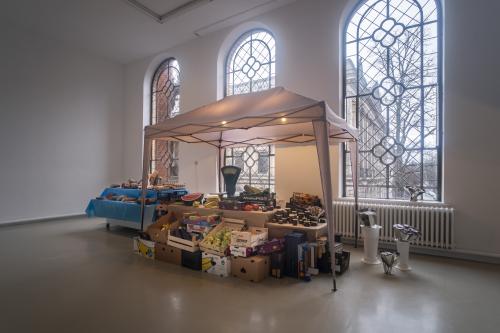
Another well-known long-term project where Kadyrova uses tiles as the primary material is her Second-Hand series (since 2014). The idea to create clothes made of ceramic tiles refers to the history of the Darnytsia Silk Mill, a former industrial center in Kyiv, which (before the war) was replaced by the shopping mall with restaurants and shops. The project tells about gentrification in the city and the change in the function of industrial buildings, which is a feature of the second-hand market. The items that were once part of the architecture of the former textile factory are hanging on a separate scaffolding in the museum space.
The series of sculptures Innocent War (2010-2014) consists of simple geometric shapes made of scrap metal found in Ukraine. For Kadyrova, these sculptures of appropriated objects painted in white point to the preservation of physical violence. Despite the room's objectlessness and an open-ended interpretation, how else can we talk about the numerous destructions of infrastructure and mutilated objects caused by the war6 if not with a cry that will be left without an answer?
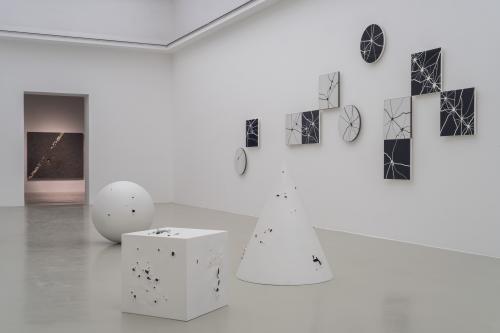
My eye was attracted to Kadyrova's project Palianytsia and the multilayered story around the creation behind the project, woven from human communication and trust.
Kadyrova and Ruban spent two weeks in the basement of their house in Rusanivka, hiding from rocket attacks and sabotage and reconnaissance groups of the occupiers, who flooded the Kyiv suburbs. Eventually, they decided to evacuate to the West of Ukraine. Residents of the Transcarpathian village of Berezovo sheltered them in a picturesque house by the river. At that time, there were no communications and electricity (the artists later organized the utilities). That's where Palianytsia, a sculptural project made of river stone, was born.
In 2022, the word "palyanytsia" meaning a bread loaf, became a password for detecting Russian saboteurs and a source of memes on social media. The project became a charity initiative and attracted attention among the Venice Biennale visitors, where it raised a considerable amount of money to help the Ukrainian army. However, at first, the project was presented where it was born. In the video documentation of the series (by Ivan Sautkin, Olena Zashko, and Anna Yaresko), one can see the contrast between the village exhibition and the project's crowded opening at the Biennale. When a local visitor to the one-day exhibition in Berezovo wants to sharpen his knife on the stone slices, the artist responds irritably: "Be careful, it's a piece of art!" (but she eventually allows him to sharpen it, as the knife does not leave a mark on the stone).
Another part of the project is a series of embroidered paintings called Alert. The artist purchased them at online auctions and the inscription Air Alert! was delegated to be embroidered over the images by the residents of Berezovo. By working in the local context, Zhanna proves she can easily engage people in her projects and have fun with the locals. She captured the memory of the people of Berezovo in a series of sketch portraits that she drew during eye-on-eye conversations about their dreams before the full-scale invasion.
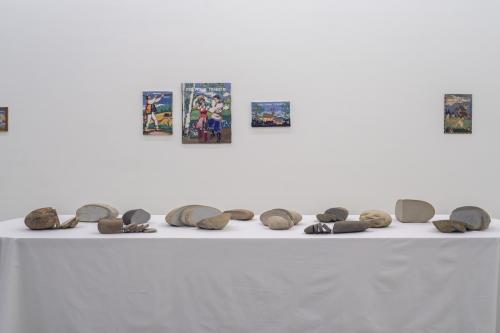
The last room of the museum is filled with indoor plants that Kadyrova took with her from the war zones when she delivered equipment to the military, which she purchased with the money raised from the Palianytsia project. The walls also feature photographs of mutilated interiors from the places the artist visited during her trip — the Kharkiv region, a library in Kherson, and a school in the village of Bohdanivka in the Kyiv region. It was from the latter place Kadyrvoa brought the flowerpots for the exhibition. Civilian and public spaces such as hospitals, libraries, theatres, or schools are regularly threatened with destruction regardless of their proximity to the frontline. In this project, Zhanna aims to convey the atmosphere of disaster and devastation that is difficult to escape for witnesses of military disasters.
Zhanna Kadyrova's works do not try to answer many complex questions at once but operate on a visual level. Her projects live their lives after they are created, gaining new interpretations and facing resistance from the European pacifist viewer. If an object evokes emotion in visitors for at least a moment, it signifies that art is a significant driver of change. Kadyrova continues to pass on her strength to others, working and making daily efforts, whether to engage with the viewer through her art or to raise funds for military equipment. The space where thousands of Ukrainian artists find themselves today is a field from which the seeds of a new future sprout. Daily bread.
The exhibition of Zhanna Kadyrova at Kunstverein Hannover runs until April, 23.
To read more articles about contemporary art please support Artslooker on Patreon
Share:



